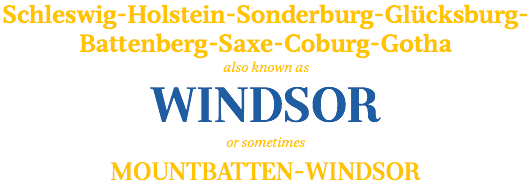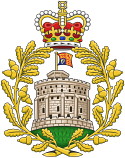
About Andrew Cusack
 Writer, web designer, etc.; born in New York; educated in Argentina, Scotland, and South Africa; now based in London.
Writer, web designer, etc.; born in New York; educated in Argentina, Scotland, and South Africa; now based in London. read more
News
Blogs
Reviews & Periodicals
Arts & Design
World
France
Mitteleuropa
Knickerbockers
Argentina
The Levant
Africa
Cape of Good Hope
Netherlands
Scandinavia
Québec
India
Muscovy
Germany
Academica
Windsor

The word conjures up majestic imagery: Windsor — the castle viewed from the Long Walk and the Royal Standard snapping above the Round Tower. At the same time, it has a strange tinge of domesticity to it, an almost middle-class quality. Perhaps a 1950s development of semi-detached suburban houses along a ‘Windsor Drive’. What on earth does the word mean?
Toponymists, those who practice the scientific study of place-names (what a fun bunch they would be on a rail journey), tell us the name comes from the Old English Windles-ore, or ‘winch by the riverside’. This seems appropriate, as the Thames is intimately linked with Windsor, winding through the Home Park and the town itself. The eponymous riverside winch was actually located in Old Windsor, the village three miles south of the town. During the reign of King Henry I, the royal household shifted upstream to ‘New’ Windsor, and most of the town took shape during the twelfth century.
The town met with hard times after the Reformation but rose in prominence from 1804, when George III moved in to the Castle, with two new army barracks being built shortly afterwards. George IV had the place transformed into the Windsor Castle we know today, through the work of the Gothic architect Jeffry Wyattville, a process which unfortunately meant the destruction of some of the baroque interiors from the age of Charles II. A devastating fire in 1992 led to a massive rebuilding and restoration program, and the Castle looks in better shape now than ever before.
 The badge of the House of Windsor
The badge of the House of WindsorOf course, while there’s the town of Windsor and Windsor Castle, one can’t think of ‘Windsor’ without considering the most famous aspect of the word: the House of Windsor. The name dates to 1917, at the height of the First World War when anti-German mass hysteria gripped Britain. The Royal Family decided to drop all its German titles, names, and styles, and other close relatives on the British side were urged to do the same.
While little is known about the decision-making process, the name of the castle by the Thames was chosen to replace the terribly German ‘Saxe-Coburg-Gotha’. On July 17, 1917, George V issued a Royal Proclamation declaring “Our House and Family shall be styled and known as the House and Family of Windsor, and that all the descendants in the male line of Our said Grandmother Queen Victoria who are subjects of these Realms, other than female descendants who may marry or may have married, shall bear the said Name of Windsor”.
The Royal Family weren’t the only ones to “rebrand”: the head of the Royal Navy, the First Sea Lord Admiral Prince Louis Alexander of Battenberg, changed his name from ‘Battenberg’ to ‘Mountbatten’ and was forced to give up his princely status. In recompense George V made him Marquess of Milford Haven, Earl of Medina, and Viscount Alderney. Visiting his son George, he wrote in the guestbook ‘Arrived Prince Hyde, Departed Lord Jekyll’. Prince Louis’ eldest daughter had Alice married into the Greek royal family in 1903, and her son, Prince Philip of Greece & Denmark, married Princess Elizabeth who know reigns as Queen Elizabeth II.
What if the House of Windsor had not suffered from teutonophobia and had instead followed normal naming conventions? They would have kept the name Saxe-Coburg-Gotha, of course. The Mountbattens would have remained the Battenbergs and brought their name into the Greek royal family (who were, of course, Danish royalty, who were, of course, German), combining Battenberg with Schleswig-Holstein-Sonderburg-Glücksburg (themselves a branch of the House of Oldenburg). Since Prince Philip married into the British branch of the Saxe-Coburg-Gotha family, this would have created a royal house with the rather charming (if inconvenient) name of Schleswig-Holstein-Sonderburg-Glücksburg-Battenberg-Saxe-Coburg-Gotha. The SHSGBSCG would have been a cadet branch of the larger house of Saxe-Coburg-Gotha, of which the current head is Andreas, Prince of Saxe-Coburg and Gotha, Duke of Saxony (b. 1943).
The Windsors, as they are today, are the reigning family of sixteen independent countries, all of whom share Elizabeth II as their monarch. While Elizabeth II is the most famous member of the House of Windsor, she is (arguably) not its head. As the most senior agnatic descendant of Victoria & Albert, Prince Richard, Duke of Gloucester, would be the head of the House of Windsor, but despite this I suspect convention would concede Elizabeth is the head-honcho.
When she ascended the throne, the Queen re-iterated the use of Windsor as the name of the house and family. This was much to the irritation of Lord Louis Mountbatten, but at a later date the Queen stipulated that any of her descendants who did not enjoy the title of prince or princess, or the style of Royal Highness, would have the surname Mountbatten-Windsor.
All that fuss over windles-ore, a riverside winch.
Search
Instagram: @andcusack
Click here for my Instagram photos.Most Recent Posts
- Faithful Shepherd of the Falklands April 8, 2025
- Articles of Note: 8 April 2025 April 8, 2025
- Proportionality Destroys Representation April 8, 2025
- Sag Harbor Cinema March 26, 2025
- Teutonic Takeover March 10, 2025
Most Recent Comments
Book Wishlist
Monthly Archives
Categories



When Kaiser Wilhelm II heard of the name change, he riposted that we couldn’t wait to see a production of “The Merry Wives of Saxe-Coburg-Gotha”.
I wonder what other names were considered by the royals when they decided to change the name?
I wonder what other names were considered by the royals when they decided to change the name?
If I recall correctly, Tudor-Stuart, Plantagenet, York, Lancaster, FitzRoy, and D’Este were among the names considered.
I neglected to add “England” as a name considered.
What no one seems to remember is that there had already been an ancient noble family of the name. Their heirs were the Crichton-Stuarts, and the then Marquess of Bute was formally asked if the family raised any objections to the Royals “expropriating” their name. There were none of course, and the foolish idea went ahead.
Oh, one other thing: “Saxe” is of course French. The real name of the family is Sachsen-Coburg und Gotha.
Sir David Oswald Hunter Blair (Abbot Oswald of Fort Augustus and Titular Abbot of Dunfermline) once “evoked a chuckle” from Prof. Robinson Ellis:
“(whimsical eymologies always pleased him) by telling him how a fifteenth-century writer had rendered the ‘Royal Collegiate Church of Windsor’ into Latin as ‘Collegium Domini
Regis de Ventomorbido’!”
Thank you for this piece. I’m puzzled by the following though:
“The Mountbattens would have remained the Battenbergs and brought their name into the Greek royal family (who were, of course, Danish royalty, who were, of course, German), combining Battenberg with Schleswig-Holstein-Sonderburg-Glücksburg (themselves a branch of the House of Oldenburg).”
Why would the Battenbergs have brought their name into the Greek royal house? It was a Battenberg princess marrying a Greek prince, one quite far down the line of succession — not a Greek sovereign Queen marrying a Battenberg prince.
It’s one of the reasons I don’t understand why sometimes people say that the Duke of Edinburgh felt slighted when the British royal house did not become the House of Mountbatten (or Mountbatten-Windsor). Does he really care that much for the Mountbatten name? It isn’t the name he was born with, not to mention that the Battenbergs are merely a morganatic branch of the grand ducal house of Hesse, a far cry from the royal house of Greece.
I think the super long name is a bit of a joke. There are several differences between the way the two last Prince Consorts were handled. Prince Albert retained his titles and style, and received none from his wife. She however, took his name. She didn’t know what it was and on one occasion had some experts inquire upon the subject; they declared her name was Wettin, and the dynasty was called Saxe-Coburg and Gotha. This is I believe the point where dynasty names became official, and determined by the court. So possibly Prince Philip could have remained a Prince of Greece and Denmark, and the last name would be Oldenburg and the dynasty of Greece, or Schleswig-Holstein-Sonderburg-Glücksburg.